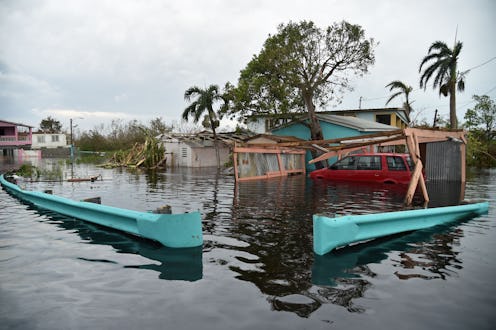News
16,000 People Are Now Homeless In This One Puerto Rican Town

The U.S. territory Puerto Rico is currently facing one of the most dire humanitarian crises in recent memory, having suffered a direct hit from Hurricane Maria last week that positively ravaged the island. It's expected that a full recovery could take years, and things are lightyears away from stable right now ― for instance, according to a report from NPR, 60 percent of the town of Catano is homeless right now, with scarce food and water, no electricity, and countless residences knocked to the ground by the massive storm.
Make no mistake, what's transpired in Puerto Rico is much the same sort of cataclysmic nightmare as what transpired last month in Texas, when Hurricane Harvey rose up out of the Gulf of Mexico to make landfall in the greater Houston area. According to reports, with the exception of some hospitals, basically the entire island is without electricity, and could be stuck without it for months.
Moreover, in addition to devastating floods and extensive property damage, 16 people have been killed, with the risk of far more damage and casualties if the Guajataca Dam gives way in the days to come. Authorities have been evacuating areas downstream of the dam, fearing that it could fail, triggering a potentially life-threatening deluge.
All this notwithstanding, the state of affairs in Catano are desperate, with well more than half of its residents now having no homes to return to. According to NPR's report, approximately 16,000 people have been displaced by the storm — Catano's population stands at about 27,000 — and are now being housed in shelters where conditions are far from sufficient.
Here's how one woman displaced by the storm, named Irma Rivera Aviles, described the state of one of the Catano shelters. By all accounts, the environments that Catano residents are forced to live in are bleak, with continuing flooding, sewage issues, and sweltering heat. She told NPR:
The governor needs to come here and take a look at our critical situation. The bathrooms flooded and aren't working, sewage is overflowing, the generator is broken and we are here in the dark. We desperately need water, power and ice.
The NPR report also quotes a 67-year-old named Carmen Huerta, a resident of Catano who's currently stuck in a shelter while suffering from high blood pressure, diabetes, and sleep apnea.
"They treat me well here, but I'm very uncomfortable," she reportedly said, with tears in her eyes.
It's no surprise that Catano is in dire straits, given the force of the storm that struck it. Maria was classified as a Category 5 hurricane when it hit the island. Category 5 is the strongest classification on the Saffir-Simpson hurricane scale ― there is no Category 6, in other words ― requiring that a storm possess winds in excess of 155 mph.
In short, both in Catano and across all of Puerto Rico, there's a severe need for humanitarian aid. Thankfully, the island's ports in San Juan have reportedly reopened to receive aid, although so far only during the daytime, a possible concession to the ongoing lack of electricity and safety measures.
While it's unclear precisely how much money it'll cost to restore the U.S. territory to its previous state, it's believed it could take years, and the dollar figure is likely to be in the tens of billions. In fact, according to a recent analysis, the price tag could top $30 billion.
As it stands now, there's an urgent need for donations to help support the people of Puerto Rico, although if you want to give some of your money, it's important to make an informed decision about which charities deserve your dollars. Journalists at The New York Times have compiled a pretty thorough list of options to choose from, so if you have the time, the inclination, and the disposable income, you might consider sending some of your money Puerto Rico's way.